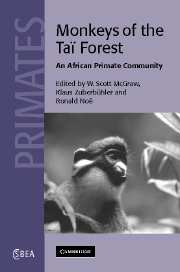Book contents
- Frontmatter
- Contents
- List of Contributors
- Preface
- 1 The monkeys of the Taï forest: an introduction
- Part I Social behavior
- Part II Anti-predation strategies
- 5 Interaction between leopard and monkeys
- 6 Interactions between red colobus monkeys and chimpanzees
- 7 Interactions between African crowned eagles and their prey community
- 8 Monkey alarm calls
- Part III Habitat use
- Part IV Conservation
- Appendix
- Index
- Plate section
- References
5 - Interaction between leopard and monkeys
Published online by Cambridge University Press: 30 July 2009
- Frontmatter
- Contents
- List of Contributors
- Preface
- 1 The monkeys of the Taï forest: an introduction
- Part I Social behavior
- Part II Anti-predation strategies
- 5 Interaction between leopard and monkeys
- 6 Interactions between red colobus monkeys and chimpanzees
- 7 Interactions between African crowned eagles and their prey community
- 8 Monkey alarm calls
- Part III Habitat use
- Part IV Conservation
- Appendix
- Index
- Plate section
- References
Summary
Introduction
Although predation is clearly a crucial factor in the evolution of primates its actual effects as a selective force are not well understood. Predation is thought to have affected various traits such as body size, group size and composition, vigilance, ecological niche, as well as vocal and reproductive behavior (van Schaik 1983, Cheney & Wrangham 1987, Cords 1990, Hill & Dunbar 1998, Stanford 1998, Uster & Zuberbühler 2001). However, there are reasons to remain cautious about many of the proposed relationships. In particular, little is known about the hunting pressure exerted by the various primate predators and the selective pressure they impose on a primate community. Nevertheless, predation is often treated as a homogeneous evolutionary force even though predators differ considerably in their hunting behavior. For instance in the Taï forest, monkeys are hunted by chimpanzees Pan troglodytes, crowned eagles Stephanoaetus coronatus, and leopards Panthera pardus. Predatory chimpanzees locate monkey groups by acoustic cues and hunt for individuals in the high canopy (Boesch & Boesch-Achermann 2000). Not surprisingly, the presence of chimpanzees reliably elicits cryptic behavior in nearby monkeys (Zuberbühler et al. 1999). Crowned eagles, in contrast, hunt by sweeping through the canopy to surprise their prey (Gautier-Hion & Tutin 1988, Shultz 2001) and their discovery typically elicits loud and conspicuous alarm calling and sometimes even mobbing behavior (Zuberbühler 2000b). Because they differ fundamentally in their hunting strategies, the selective force of chimpanzees, leopards, and eagles – as predators – is not homogeneous.
Information
- Type
- Chapter
- Information
- Monkeys of the Taï ForestAn African Primate Community, pp. 133 - 154Publisher: Cambridge University PressPrint publication year: 2007
